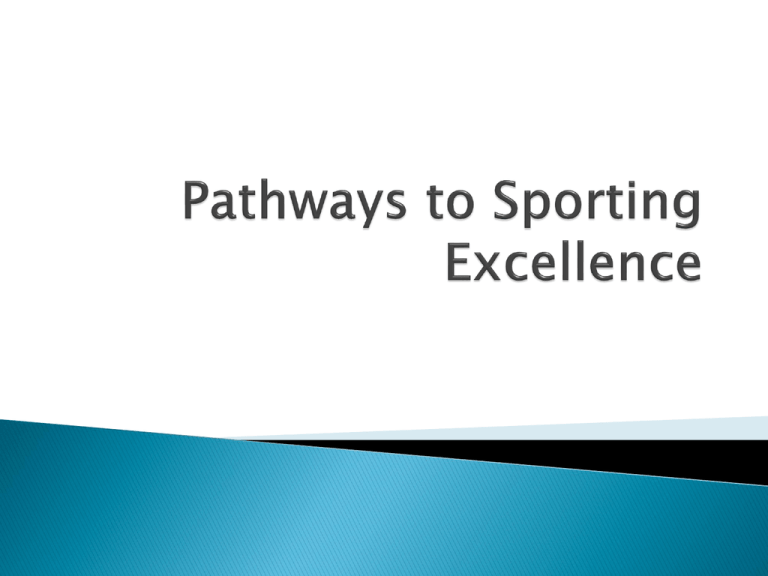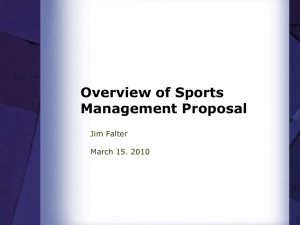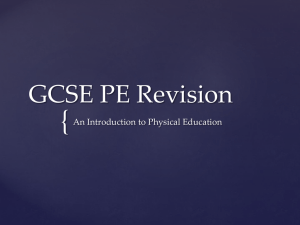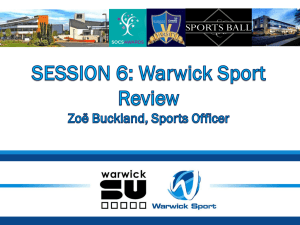Pathways to Sporting Excellence
advertisement

Historically there were two main pathways for aspiring athletes EDUCATION e.g. PE lessons SHOOL i.e. School team CLUB e.g. local social club LOCAL JUNIOR CLUB e.g. Playing in local league REGIONAL TEAM e.g. County team ELITE CLUB e.g. First division team SENIOR CLUB e.g. Playing in regional league ELITE CLUB e.g. First division club This was largely determined by the sport but some took both routes e.g. Rugby, netball UK Sport has made more of an emphasis on club structure. PESSCL and Sports Colleges have brought the two pathways together. Private schools dominated the traditional pathways. In the last fifty years 50% of all Olympic medal winners come from this sector but it only accounts for 5% of the population. School sport meant friendly competitive fixtures in a range of sports. There is a large number of school sports associations running both regional and national competitions e.g. English Schools FA The main criticism is that this only caters for only a small percentage of the population as only around 5% of pupils are involved in competitive sport. The traditional pathway for sporting excellence in school is School e.g. Bangor High School District e.g. North Gwynedd County e.g. Gwynedd Regional e.g. North Wales National School sport is run by volunteers – i.e. teachers e.g.Wales Universities provide opportunities for all levels of performance. They have an extensive range of facilities. Inter mural sport allows a greater range of students to participate at a lower level. Many Universities e.g. Loughborough, Bath have allowed elite athletes to train alongside their academic course. Some award scholarships and bursaries to help students fund sports training and development. There are also sport specific degrees. There are University sports competitions e.g. UAU, BUSA and varsity games like Oxford v Cambridge. The government have recently developed and published a range of documents and policies that set out its objectives for the 21st century. 1. National Framework for Sport is a joint policy developed by the government and key sports agencies which sets out a vision for Sport England under the heading “ Making England and Active and Successful Nation – a vision for 2020” It aims to change the culture of sport and physical activity in England to increase participation across all social groups. It identifies 20 priority sports and 10 development sports. It is a conceptual model which challenges all involved to consider what the issues are and then works towards the changes needed in terms of culture and provision so that England becomes a successful sporting nation both for mass participation and excellence. 2. Game Plan was developed in 2002 as a strategy for delivering sport and physical activity objectives for the nation. Aims are to increase participation because of the significant health benefits they bring and therefore reduce the growing costs of inactivity. Also to gain a sustainable improvement in success in international competition in sports that matter to the public. It’s targets are to get 70% of the population reasonably active by 2020 and that British / English teams and individuals sustain top 5 ranking. The UK government and the sports agencies hope that the streamlined structure reduces beaurocracy and releases sporting potential in as many as possible. 3. Sport Search Programmes. The identification of sports talent in young people should be a priority in a run up to the 2012 games. This is an online system which allows 11-17 year olds to assess their suitability in over 150 sports and giving links on where to pursue these sports. This is the process of identifying potential in young people and providing supportive pathways that allow them to progress and fulfil this talent. This is not an easy process as most physical characteristics are mapped against specific sports but this can not identify desire, determination and mental toughness needed for success. Talent Identification works best in closed loop sports which are repetitive in nature e.g. Rowing, cycling, weight lifting, swimming where there is a clear link to defined characteristics Open looped sports e.g. Tennis, football involve decision making, spacial awareness etc so talent identification is less accurate. Explain the role schools, colleges, and universities play in providing a pathway for sports progression. Outline recent initiatives that have been introduced to raise the standard of school sport and physical education.







